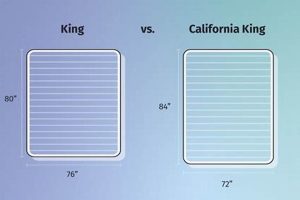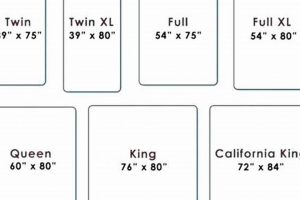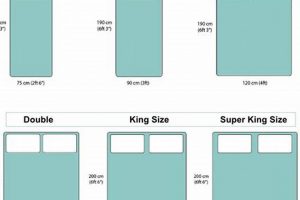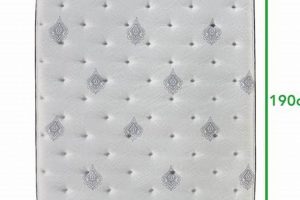Mattress measurements commonly referred to as “full” and “queen” represent standardized sizes designed to accommodate varying sleeper needs and room dimensions. The former typically measures approximately 54 inches in width and 75 inches in length, while the latter expands to roughly 60 inches wide and 80 inches long. These figures serve as industry benchmarks, though slight variations may occur between manufacturers.
Selecting the correct mattress proportions is crucial for ensuring adequate sleep space and optimizing bedroom layout. A larger sleeping surface promotes freedom of movement and minimizes partner disturbance, contributing to improved rest quality. Historically, mattress sizes have evolved to meet changing societal preferences and housing trends, reflecting a growing emphasis on personal comfort and space utilization within the home.
The subsequent sections will delve into a more detailed comparison of these common mattress formats, exploring the practical considerations for choosing between them, analyzing their impact on bedding compatibility, and assessing their suitability for different individuals and sleeping arrangements.
Essential Considerations
The following guidelines offer a practical approach to determining the most appropriate mattress format based on individual needs and spatial limitations, prioritizing informed decision-making.
Tip 1: Evaluate Occupancy. Determine the number of individuals who will regularly occupy the mattress. A full-size configuration is generally sufficient for a single sleeper, while a queen-size offers enhanced space for couples or individuals who prefer greater freedom of movement.
Tip 2: Measure Bedroom Space. Accurately measure the available floor area within the bedroom. Ensure that the chosen mattress allows for comfortable movement around the bed and accommodates other essential furniture pieces.
Tip 3: Consider Sleeper Height. Taller individuals may benefit from the added length of a queen-size mattress. The extra inches can prevent discomfort caused by feet extending beyond the mattress edge.
Tip 4: Assess Budget Constraints. Queen-size mattresses typically command a higher price point than full-size models. Factor in the cost of associated bedding, such as sheets and comforters, which also vary in price based on size.
Tip 5: Review Bedding Compatibility. Ensure that existing or planned bedding is appropriately sized for the selected mattress format. Ill-fitting sheets can detract from comfort and reduce the lifespan of both the mattress and bedding.
Tip 6: Anticipate Future Needs. Consider potential changes in living arrangements or sleeping partners. Selecting a larger mattress size may prove advantageous in the long term, mitigating the need for future replacements.
These considerations should assist in selecting a mattress that aligns with specific requirements, promoting improved sleep quality and optimizing the functionality of the sleeping environment.
The subsequent section will explore the specific applications and suitability of each mattress type in greater detail, providing a comprehensive overview of their respective advantages and limitations.
1. Width Difference
The “Width Difference” between full size and queen size mattresses constitutes a primary factor influencing comfort and spatial considerations. This dimension directly affects the sleeping area available per individual and the overall suitability of the mattress for specific room layouts.
- Individual Sleeper Space
The 6-inch difference in width provides significantly more personal space for individual sleepers. This additional area can improve sleep quality by minimizing feelings of confinement and allowing for greater freedom of movement throughout the night. For restless sleepers, a wider mattress reduces the likelihood of disturbing a partner or rolling off the bed.
- Suitability for Couples
For couples, the “Width Difference” is even more critical. While a full-size mattress may prove cramped, a queen-size offers a more equitable distribution of space. This can mitigate disturbances caused by partner movement and enhance overall sleep harmony. Adequate width is essential for preventing the sensation of being crowded or restricted during sleep.
- Bedroom Size Constraints
The width of a mattress directly impacts the usable space within a bedroom. A full-size mattress is often a practical choice for smaller rooms where space is limited, whereas a queen-size may require a larger area to maintain comfortable movement and prevent the room from feeling overcrowded. The “Width Difference” must be carefully considered in relation to overall room dimensions.
- Impact on Bedding Costs
The wider dimensions of a queen-size mattress translate to increased costs for bedding. Sheets, comforters, and other accessories tailored for queen-size beds are generally more expensive than their full-size counterparts. The “Width Difference” contributes directly to these price variations, necessitating budgetary considerations when selecting a mattress size.
In conclusion, the “Width Difference” between full size and queen size mattresses represents a crucial determinant of sleeping comfort, spatial efficiency, and overall cost. A thorough evaluation of these factors is essential to ensuring a well-informed decision that aligns with individual needs and bedroom parameters.
2. Length Variation
The “Length Variation” between full size and queen size mattresses represents a significant differentiator that directly impacts comfort, particularly for taller individuals. This dimensional aspect necessitates careful consideration when selecting a mattress to ensure adequate support and restful sleep.
- Accommodating Taller Individuals
The additional five inches in length offered by a queen-size mattress compared to a full-size can be crucial for individuals exceeding approximately 5’10” in height. This extra length prevents discomfort caused by feet hanging off the edge of the bed, ensuring proper spinal alignment and reducing potential sleep disturbances. A full-size mattress may prove insufficient for taller sleepers, leading to compromised sleep quality.
- Impact on Spinal Alignment
Insufficient mattress length can negatively affect spinal alignment. When the body is forced to contort or curl to fit on a shorter mattress, it can strain the back muscles and lead to discomfort or pain. The “Length Variation” offered by a queen-size mattress provides greater opportunity for maintaining a neutral spinal position throughout the night, promoting healthier sleep posture.
- Perception of Spaciousness
Even for individuals of average height, the “Length Variation” can contribute to a greater sense of spaciousness and comfort. The additional length allows for more freedom of movement and reduces the feeling of being confined to a limited area. This can be particularly beneficial for individuals who tend to shift positions frequently during sleep.
- Long-Term Investment Considerations
Choosing a mattress with sufficient length can be viewed as a long-term investment in sleep quality. As individuals age, their bodies may become more sensitive to inadequate support or uncomfortable sleeping positions. Selecting a queen-size mattress, with its additional length, can help to mitigate these potential issues and ensure continued comfort over time.
In summary, the “Length Variation” between full size and queen size mattresses is a critical factor influencing comfort, spinal alignment, and overall sleep quality. Careful consideration of individual height and sleeping preferences is essential when choosing between these two sizes to ensure a restful and supportive sleep experience. The longer dimensions of a queen offer specific advantages that should be weighed against spatial and budgetary constraints.
3. Bedroom Footprint
The available “Bedroom Footprint” significantly dictates the feasibility and practicality of accommodating either a full size or queen size mattress. The dimensions of the room must be carefully considered to ensure comfortable movement and a balanced aesthetic. Selecting an inappropriately sized mattress can lead to spatial inefficiencies and a compromised living environment.
- Traffic Flow and Accessibility
A crucial aspect of “Bedroom Footprint” planning involves maintaining adequate traffic flow. A larger mattress necessitates more surrounding space for unimpeded movement between furniture pieces and access to closets or windows. Insufficient space can lead to obstructions, making the room feel cramped and less functional. For instance, a small bedroom may comfortably accommodate a full-size mattress, leaving ample space for walkways and dressers, while a queen-size could significantly restrict movement.
- Furniture Placement and Proportion
The “Bedroom Footprint” directly influences furniture placement. A larger mattress reduces the available wall space for other essential items, such as nightstands, dressers, or desks. Careful consideration must be given to maintaining proportional balance within the room. A queen-size mattress in a small bedroom may necessitate smaller, more compact furniture, potentially compromising storage capacity or functionality.
- Visual Aesthetics and Spaciousness
The perceived spaciousness of a bedroom is heavily influenced by the ratio of mattress size to “Bedroom Footprint.” A room dominated by a large mattress can feel visually smaller and more confined. Conversely, a smaller mattress in a larger room may appear disproportionate and less inviting. Thoughtful planning is required to achieve a harmonious balance between the mattress and the overall room dimensions, optimizing visual appeal and comfort.
- Future Flexibility and Adaptability
Consideration of the “Bedroom Footprint” should extend to anticipating future needs. While a full-size mattress may be suitable for a single individual in a small apartment, future relocation to a larger space or the addition of a partner may necessitate a larger mattress and a re-evaluation of the room’s layout. Planning for potential changes ensures long-term spatial efficiency and adaptability.
In summary, the “Bedroom Footprint” serves as a critical constraint in determining the appropriate mattress size. The decision between a full size and queen size mattress must be guided by a comprehensive assessment of the room’s dimensions, traffic flow, furniture placement, visual aesthetics, and future needs. A well-considered approach optimizes spatial efficiency, enhances comfort, and contributes to a more harmonious and functional living environment.
4. Cost Implications
The relationship between “Cost Implications” and mattress measurements is a tangible consideration for consumers. Varying dimensions between full and queen sizes directly influence pricing structures, affecting both initial purchases and long-term expenditures related to bedding accessories.
- Initial Purchase Price
Queen-size mattresses consistently command a higher initial purchase price compared to full-size models. This disparity arises from increased material requirements and manufacturing complexities associated with the larger surface area. Consumers should anticipate a notable price difference, often ranging from 20% to 50%, depending on the brand, materials, and construction techniques employed. For example, a mid-range memory foam mattress in full size might retail for $500, whereas the equivalent queen-size could cost $700 or more. This initial cost differential represents a significant factor for budget-conscious buyers.
- Bedding Accessories Expense
The “Cost Implications” extend beyond the mattress itself to encompass bedding accessories. Queen-size sheets, comforters, mattress protectors, and bed frames are typically more expensive than their full-size counterparts. This increased expense reflects the larger dimensions and greater material consumption required to produce these items. Purchasing a complete set of bedding for a queen-size bed can substantially elevate the overall investment, particularly when opting for high-quality materials or designer brands. These recurring expenses should be factored into the long-term cost analysis.
- Shipping and Handling Fees
Larger mattress sizes often incur higher shipping and handling fees. Queen-size mattresses, due to their increased weight and bulk, necessitate more extensive logistical arrangements and may require specialized delivery services. Retailers may charge additional fees for oversized items, reflecting the increased labor and equipment needed for transportation. Furthermore, in-home setup and assembly services, if required, can also contribute to higher overall costs. These logistical expenses should be considered when comparing the “Cost Implications” of different mattress sizes.
- Long-Term Replacement Costs
While not immediately apparent, the decision between full and queen size mattresses can influence long-term replacement costs. A queen-size mattress, offering more space and durability, may exhibit a longer lifespan compared to a full-size mattress subjected to similar usage patterns. The increased surface area distributes weight more evenly, potentially reducing wear and tear. Furthermore, a larger mattress may be more adaptable to changing needs over time, mitigating the need for premature replacement. Consequently, the long-term “Cost Implications” should consider the potential differences in durability and adaptability between mattress sizes.
In conclusion, the “Cost Implications” associated with full and queen size mattress dimensions extend beyond the initial purchase price, encompassing bedding accessories, shipping fees, and potential long-term replacement costs. A comprehensive budgetary analysis should consider these multifaceted factors to ensure an informed and financially sound decision. Balancing cost considerations with individual needs and spatial constraints remains paramount in optimizing the overall value proposition.
5. Bedding Needs
The selection of appropriately sized bedding is intrinsically linked to the chosen mattress dimensions. This interdependence directly impacts comfort, aesthetics, and the overall functionality of the sleep environment. A mismatch between bedding and mattress size can lead to discomfort, diminished aesthetic appeal, and reduced product lifespan.
- Sheet Fit and Performance
The dimensions of fitted and flat sheets are paramount for ensuring a secure and comfortable fit. Ill-fitting sheets can bunch, slip off the mattress, or restrict movement during sleep. Full-size sheets are designed to accommodate mattresses measuring approximately 54 inches wide by 75 inches long, while queen-size sheets are tailored for mattresses around 60 inches wide by 80 inches long. Using full-size sheets on a queen mattress will result in insufficient coverage, whereas queen-size sheets on a full mattress may create excess fabric and a sloppy appearance. The proper sheet size is crucial for optimizing comfort and prolonging the sheet’s lifespan.
- Comforter and Quilt Coverage
Comforters and quilts serve not only as insulators but also as decorative elements within the bedroom. The dimensions of these items must adequately cover the mattress surface while also providing a visually balanced overhang. A comforter that is too small will leave the sides of the mattress exposed, detracting from the overall aesthetic. Conversely, an excessively large comforter can overwhelm the bed and create a bulky appearance. Manufacturers typically provide size recommendations based on mattress dimensions, ensuring an appropriate level of coverage and visual appeal. Full size comforters are typically around 76″ x 86″ and Queen size comforters typically around 86″ x 86″ to 88″ x 92″
- Pillow Sizing and Quantity
The selection of pillows and their arrangement on the bed contribute significantly to both comfort and visual aesthetics. Standard pillows, typically measuring 20 inches by 26 inches, are commonly used on full-size beds. Queen-size beds often accommodate standard or queen-size pillows (20 inches by 30 inches), with two pillows being the standard, or three pillows for a fuller look. The choice of pillow size and quantity should be proportionate to the mattress dimensions and the sleeper’s preferences. Insufficient pillow support can lead to neck strain, while an excessive number of pillows can create a cluttered appearance.
- Bed Frame Compatibility
The bed frame provides structural support for the mattress and contributes to the overall style of the bedroom. The frame dimensions must precisely match the mattress dimensions to ensure stability and prevent damage to the mattress. A full-size mattress placed on a queen-size frame will lack adequate support, potentially leading to sagging or premature wear. Conversely, a queen-size mattress forced onto a full-size frame may overhang the edges, creating an unstable and visually unappealing arrangement. Verifying compatibility between the mattress and bed frame dimensions is essential for safety and longevity.
In conclusion, the selection of appropriately sized bedding is inextricably linked to mattress dimensions. The dimensions of sheets, comforters, pillows, and bed frames must align with the full or queen size mattress to ensure comfort, aesthetic appeal, and optimal product performance. Careful attention to these details will contribute to a well-coordinated and functional sleep environment.
6. Occupancy Suitability
The appropriateness of mattress dimensions is critically linked to occupancy, dictating the level of comfort and rest quality experienced by sleepers. Mattress size must align with the number of occupants and their individual needs to ensure adequate space and minimize sleep disruption. Discrepancies between mattress size and occupancy can lead to discomfort, reduced sleep efficiency, and strained sleeping arrangements.
- Single Occupancy Dynamics
For single individuals, a full-size mattress provides sufficient space for comfortable sleep, particularly in smaller bedrooms where maximizing floor space is essential. However, individuals who prefer greater freedom of movement or tend to toss and turn during the night may find the dimensions of a queen-size mattress more accommodating, even for single occupancy. A larger sleeping surface reduces the feeling of confinement and allows for unrestricted movement. Consider a single adult in a small urban apartment where space is a premium. While a queen bed might be desired, a full-size mattress may be the more practical choice to allow for other furniture and comfortable navigation of the room.
- Dual Occupancy Considerations
When accommodating two occupants, a queen-size mattress generally represents the minimum acceptable size for ensuring adequate personal space and minimizing sleep disturbances. The additional width compared to a full-size mattress allows for a more equitable distribution of space, reducing the likelihood of partners disturbing each other’s sleep. Couples who value personal space or have differing sleep schedules often benefit from the increased surface area of a queen-size mattress. For instance, a couple sharing a bed may find a full-size mattress cramped and disruptive, leading to restless sleep and potential partner disturbance. Upgrading to a queen size generally provides greater comfort.
- Children Sharing a Sleeping Surface
In certain circumstances, such as siblings sharing a room, a full-size mattress may be deemed adequate for two children. However, factors such as the children’s ages, sizes, and sleep habits should be carefully considered. As children grow, their need for personal space increases, and a larger mattress may become necessary to prevent discomfort and sleep disturbances. A parent might initially opt for a full-size bed when their children are young, but as the children mature and require more space, switching to two twin beds or a queen-size may be beneficial.
- Guest Accommodation Suitability
The suitability of a full or queen-size mattress for guest accommodations depends on the anticipated occupancy and the available space. A full-size mattress may suffice for single guests or couples who are comfortable sharing a smaller sleeping surface. However, providing a queen-size mattress offers greater flexibility and can accommodate a wider range of guests, including couples or individuals who prefer more personal space. A homeowner setting up a guest room would need to think about what the usual requirements of a guest would be and then choose accordingly.
In summation, aligning mattress dimensions with occupancy needs is paramount for optimizing sleep quality and ensuring a comfortable sleeping environment. A careful evaluation of individual preferences, spatial constraints, and anticipated occupancy patterns is essential for selecting the most appropriate mattress size, contributing to improved rest and overall well-being.
Frequently Asked Questions
The following section addresses common inquiries concerning mattress measurements, specifically focusing on the distinctions between “full size and queen size mattress dimensions.” The information provided aims to clarify potential points of confusion and facilitate informed decision-making.
Question 1: What are the precise measurements of a full-size mattress?
A full-size mattress, also known as a double mattress, typically measures approximately 54 inches in width and 75 inches in length. These dimensions may vary slightly depending on the manufacturer, but these values represent the industry standard.
Question 2: What are the precise measurements of a queen-size mattress?
A queen-size mattress generally measures approximately 60 inches in width and 80 inches in length. Similar to full-size mattresses, minor variations in dimensions may exist across different brands and models.
Question 3: Is a queen-size mattress significantly larger than a full-size mattress?
Yes, a queen-size mattress offers a notable increase in surface area compared to a full-size mattress. The queen-size provides 6 additional inches of width and 5 additional inches of length, translating to a larger sleeping surface for individuals or couples.
Question 4: Is a full-size mattress suitable for couples?
While a full-size mattress can accommodate two adults, it may prove cramped for some couples. The limited width can restrict movement and potentially disrupt sleep. A queen-size mattress is generally recommended for couples to ensure adequate personal space.
Question 5: Does the choice of mattress size impact bedding costs?
Yes, mattress size directly influences bedding costs. Queen-size sheets, comforters, and other bedding accessories are typically more expensive than their full-size counterparts due to the increased material required.
Question 6: How should room size influence mattress selection?
Room size is a critical factor in mattress selection. A smaller bedroom may be better suited for a full-size mattress to maximize floor space and allow for comfortable movement. A larger bedroom can comfortably accommodate a queen-size mattress without feeling cramped.
In summary, comprehending the precise measurements and associated considerations of mattress sizes is essential for optimizing sleep quality and ensuring a comfortable and functional bedroom environment. Factors such as occupancy, room size, and budget should be carefully weighed to make an informed decision.
The subsequent section will provide a concise summary of the key differences between full size and queen size mattress dimensions and offer concluding recommendations.
Summary
The preceding analysis has explored the critical distinctions between full size and queen size mattress dimensions, emphasizing the importance of considering spatial constraints, occupancy requirements, and budgetary limitations. Key factors influencing the selection process include individual sleeper needs, the overall bedroom footprint, and the long-term implications for bedding expenses. The provided information serves to equip consumers with the knowledge necessary to make informed decisions regarding mattress purchases.
Ultimately, the decision to opt for a full or queen size mattress requires careful deliberation and a thorough assessment of personal circumstances. As mattress technology continues to evolve and individual preferences diversify, a comprehensive understanding of dimensional considerations remains paramount for optimizing sleep quality and maximizing overall comfort within the sleeping environment. Choosing wisely ensures a lasting investment in rest and well-being.







